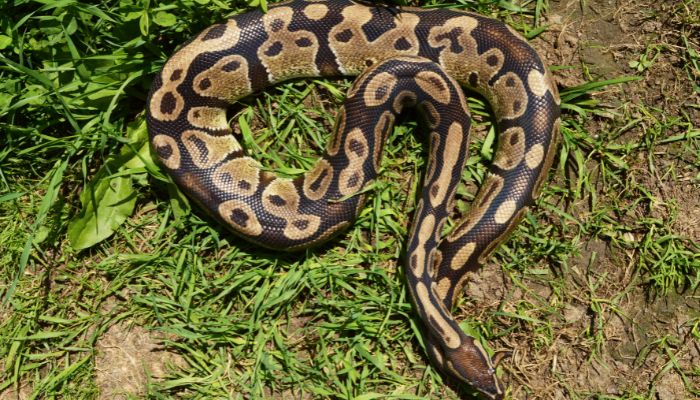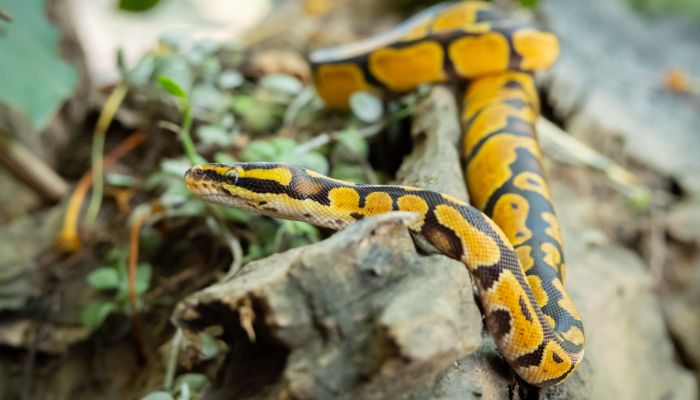Diving into the world of ball pythons is a mesmerizing journey, especially when it comes to breeding.
Breeding season for ball pythons typically peaks during the winter months. However, they can breed year-round in captivity. It’s essential to observe individual pythons for readiness cues, such as increased activity and changes in feeding habits, to determine the optimal breeding time.
This article delves deep into the nuances of ball python breeding, from determining their readiness to the care of fresh hatchlings.
We’ll explore the signs of ovulation, the intricacies of pairing, and answer some burning questions you might have.
Armed with insights and a touch of wonder, let’s unravel the mysteries of these magnificent creatures together.

Table of Contents
- 1 Determining When Ball Pythons are Ready to Breed
- 1.1 No Fixed Size or Age for Breeding
- 1.2 Importance of Considering Both Age and Weight
- 1.3 Guidelines for Females: Third Winter, Weight Considerations, and Age Factors
- 1.4 Guidelines for Males: Weight, Feeding Habits, and Age Considerations
- 1.5 The Dangers of Pushing Females Too Early for Breeding
- 1.6 The Potential for Males to Breed in Their First Season
- 2 Pairing Ball Pythons
- 3 Ovulation and Pre-Lay Shed
- 4 Incubation of Ball Python Eggs
- 5 Post-Laying Care for Female Ball Pythons
- 6 Setting Up and Caring for Hatchlings
- 7 Conclusion
- 8 More Questions
Determining When Ball Pythons are Ready to Breed
When it comes to breeding, there’s a lot to consider. Let’s dive deep into the nitty-gritty of determining when these slithering beauties are ready to breed.
No Fixed Size or Age for Breeding
First things first, there’s a common misconception floating around: “There’s a specific size or age for breeding ball pythons.” Well, let’s debunk that myth right away. Unlike some animals that have a clear-cut age or size for breeding, ball pythons are a bit more flexible.
It’s like saying there’s a specific age for humans to get married. Sounds absurd, right?
Importance of Considering Both Age and Weight
Now, while there’s no strict rule, it doesn’t mean you should pair up any two ball pythons and expect magic to happen. Age and weight play a crucial role. Think of it as a balance. Just as you wouldn’t expect a toddler to lift weights, you wouldn’t want a young, underweight python to breed.
Guidelines for Females: Third Winter, Weight Considerations, and Age Factors
For the lovely ladies, the general consensus is that they should be experiencing their third winter before they’re introduced to a male. Why? It’s all about maturity. By this time, they’ve had enough time to grow and develop.
Weight is another factor.
A healthy weight indicates that she’s ready to carry eggs. Typically, females weighing around 1500 grams are considered ideal for breeding. But remember, it’s not just about the numbers. Observing her behavior and ensuring she’s in good health is paramount.
Guidelines for Males: Weight, Feeding Habits, and Age Considerations
On to the gents! Males are a bit more eager when it comes to breeding. They can potentially breed during their first season. However, it’s essential to ensure they’re healthy and have consistent feeding habits.
A male weighing around 600 grams with a good appetite is generally considered ready. But again, don’t just go by the scales. Observing his behavior and ensuring he’s not stressed is equally important.
The Dangers of Pushing Females Too Early for Breeding
Now, a word of caution. In the excitement of breeding, some might be tempted to push their female pythons into breeding too early. This can be detrimental. Breeding a young or underweight female can lead to complications, stress, and even health issues.
It’s like expecting a teenager to take on the responsibilities of an adult. They’re just not ready. So, patience is key.
The Potential for Males to Breed in Their First Season
As mentioned earlier, males can be quite eager. Some have been known to breed successfully in their first season. But this doesn’t mean every male should. Just because he can, doesn’t mean he should. It’s essential to ensure he’s mature enough, both in size and behavior.
After all, quality over quantity, right?

Pairing Ball Pythons
Breeding ball pythons isn’t just about knowing when they’re ready. It’s also about understanding the art of pairing them. Let’s delve into the intricacies of this process and what you need to know to make the magic happen.
The Year-Round Breeding Season
One of the fascinating things about ball pythons is their flexibility when it comes to breeding. Unlike some species that have a strict breeding season, ball pythons can potentially breed year-round.
However, most breeders prefer the winter months, as this is when pythons in the wild would typically mate. But remember, while they can breed throughout the year, it doesn’t mean they should. It’s essential to ensure both pythons are in optimal health and condition.
Observing Female Behavior for Pairing
Females have a way of letting you know when they’re ready. They might become more active, searching their enclosure, or even refusing food. These are signs she’s gearing up for the breeding season. It’s like she’s dropping hints, saying, “Hey, I’m ready for some company!”
Observing and understanding these subtle cues can make the difference between successful and unsuccessful pairings.
Room Temperature and Hot Spots Considerations
Temperature plays a pivotal role in the breeding process. Ball pythons, being ectothermic, rely on external heat sources. A slight drop in room temperature, paired with a maintained hot spot in their enclosure, can signal the onset of the breeding season.
It’s like setting the mood with some ambient lighting. The right temperature can stimulate and encourage mating behaviors.
Pairing Schedules and Frequency
Now, while we’re all for letting nature take its course, a little planning never hurt anyone. Setting a pairing schedule, like introducing the male to the female every few days, can increase the chances of successful mating. But don’t overdo it. Too much of a good thing can stress the pythons.
Importance of Monitoring and Documenting Pairings
Documentation is key. Keeping a record of when you paired the pythons, their behavior, and any observed mating can be invaluable. It helps track the female’s cycle, anticipate ovulation, and even predict when she might lay eggs. Think of it as a diary of their love story.
Visual Cues of Successful Pairing
Ah, the moment we’ve all been waiting for! Successful pairing often results in the male wrapping his tail around the female’s, a dance of sorts. You might also notice them staying close together, almost intertwined. It’s a beautiful sight, signaling the promise of new life.

Ovulation and Pre-Lay Shed
Breeding ball pythons is a journey, and ovulation is one of its most critical milestones. It’s like the crescendo in a symphony, signaling that the main event is just around the corner. Let’s explore this fascinating phase in the breeding process.
Signs of Follicle Development in Females
Before ovulation, females undergo follicle development. These follicles, which will eventually become eggs, can sometimes be felt or even seen as lumps in the lower third of the snake’s body. It’s akin to a mother-to-be’s growing belly, a subtle yet sure sign that something wonderful is brewing.
Behavioral Changes in Females During the Breeding Season
As the follicles grow, you might notice some behavioral changes in the female. She might bask more, seeking out the warmest parts of her enclosure, or she might become restless. It’s as if she’s preparing herself, both mentally and physically, for what’s to come.
The Process of Ovulation and Its Significance
Ovulation in ball pythons is hard to miss. The female’s mid-body swells noticeably, almost looking like she’s swallowed a tennis ball. This swelling indicates that the follicles are moving into the oviducts, ready to be fertilized. It’s a clear sign that the pairing was successful and that eggs are on the way.
The Pre-Lay Shed Cycle and Its Timing
After ovulation, the female goes through a pre-lay shed, which is her last shed cycle before laying eggs. This typically happens about two weeks after ovulation. It’s like nature’s way of saying, “Get ready, the big day is approaching!”

Incubation of Ball Python Eggs
Once the eggs are laid, the real patience game begins. Incubation is a delicate process, requiring attention to detail and a whole lot of waiting.
Preparing the Eggs for Incubation
First, gently remove the eggs from the female’s enclosure, ensuring you don’t rotate or flip them. Mark the top of each egg with a non-toxic marker. This helps in keeping them oriented correctly during incubation.
Identifying and Discarding Slugs (Unfertilized Eggs)
Not all eggs are destined to become hatchlings. Slugs, which are yellowish, smaller, and often misshapen, are unfertilized eggs. They won’t produce baby pythons and should be removed from the clutch.
Setting Up the Incubation Environment
The ideal incubation environment is humid and warm. Set up an incubator at a steady temperature of around 88-90°F (31-32°C) with high humidity. Many breeders use vermiculite or perlite as a substrate to maintain moisture.
Monitoring the Eggs During Incubation
Regularly check the eggs for mold or any signs of decay. Ensure the humidity remains consistent. It’s like babysitting, ensuring the little ones are comfortable and safe.
The Debate Over Cutting Ball Python Eggs
As the incubation period nears its end, some breeders choose to cut the eggs to help the hatchlings emerge. However, this is a topic of debate. While some believe it aids the hatchlings, others prefer to let nature take its course. Whichever side you lean on, always prioritize the well-being of the hatchlings.

Post-Laying Care for Female Ball Pythons
After the exhilarating experience of laying eggs, our female ball python deserves some top-notch TLC. It’s like she’s run a marathon, and now it’s time for some well-earned rest and recuperation.
Cleaning and Resetting the Female’s Environment
First and foremost, give her enclosure a thorough cleaning. Remove any remnants of the eggs or the nesting material. It’s akin to freshening up a room after a big event, making it cozy and comfortable for her to relax.
Importance of Removing Breeding Season Pheromones
During the breeding season, females release specific pheromones. Now that she’s done laying, it’s essential to remove any traces of these pheromones. Think of it as clearing out the remnants of a party. It helps her transition back to her regular routine without any distractions.
Getting the Female Back on a Feeding Schedule
Post-laying, the female might be off her food for a bit. But with gentle encouragement and patience, she’ll get back to her regular feeding habits. It’s all about understanding her needs and ensuring she gets the nutrition she requires to recover fully.

Setting Up and Caring for Hatchlings
The arrival of hatchlings is like the grand finale of the breeding process. These tiny wonders bring a whole new set of responsibilities and joys.
Separating and Housing Baby Ball Pythons
Once the hatchlings emerge, it’s essential to house them separately. Individual containers or tubs work best. It ensures they have their own space and reduces any chances of competition or stress.
The First Shed Cycle of the Hatchlings
Within the first two weeks, these little ones will go through their first shed cycle. It’s a significant milestone, signaling their growth and development. Ensure their environment is humid enough to facilitate a smooth shedding process.
Feeding Recommendations for Baby Ball Pythons
Feeding baby ball pythons can be a tad tricky. Start with small prey items, like pinkie mice. Remember, the key is patience. Some might be hesitant eaters initially, but with gentle persistence, they’ll get the hang of it.
Conclusion
You’ve journeyed through the captivating world of ball python breeding, understanding their readiness, the art of pairing, and the care they require post-laying.
From ovulation signs to hatchling care, the process is intricate yet rewarding. As you delve deeper into this realm, remember that patience and observation are your best allies.
Every snake is unique, and their cues will guide you. Embrace the learning curve, and soon, you’ll be a master in the art of ball python breeding.
Keep going, and let your passion lead the way!
More Questions
Let’s tackle some of the most commonly asked ones, shall we?
Can Ball Pythons Breed Year Round?
Technically, yes, ball pythons have the ability to breed year-round. However, most breeders prefer the winter months, mimicking their natural breeding season in the wild. But remember, just because they can, doesn’t always mean they should. It’s essential to ensure both pythons are in optimal health and condition.
What Age Do Ball Pythons Lay Eggs?
While there’s no strict age, female ball pythons typically start laying eggs around their third winter, provided they’ve reached the appropriate weight and health conditions.
How Long After Ovulation Do Ball Pythons Lay?
After the noticeable swelling of ovulation, females usually lay their eggs in about 30 to 45 days. It’s a period of anticipation, much like waiting for the grand finale of a show.
How Do I Know When My Snake is Ready to Breed?
Look for signs! Females might become more active, refuse food, or show visible follicle development. Males might become more restless and show increased interest in the females.
Can 2 Male Ball Pythons Live Together?
It’s not recommended. While ball pythons are generally docile, housing two males together can lead to competition and stress. It’s always best to give each snake its own space to thrive.




0 Comments